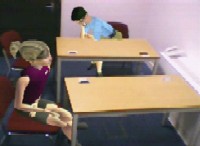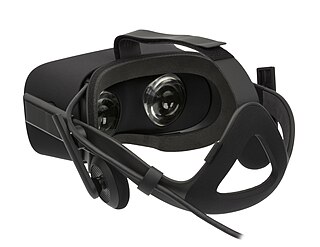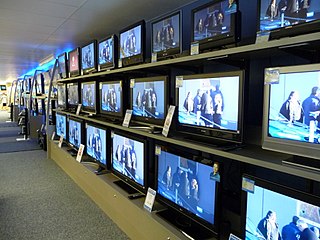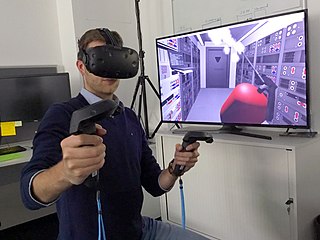
Cyberspace is widespread, interconnected digital technology. The term entered the popular culture from science fiction and the arts but is now used by technology strategists, security professionals, government, military and industry leaders and entrepreneurs to describe the domain of the global technology environment. Others consider cyberspace to be just a notional environment in which communication over computer networks occurs. The word became popular in the 1990s when the uses of the Internet, networking, and digital communication were all growing dramatically and the term "cyberspace" was able to represent the many new ideas and phenomena that were emerging.
Reality is the sum or aggregate of all that is real or existent, as opposed to that which is merely imaginary. The term is also used to refer to the ontological status of things, indicating their existence. In physical terms, reality is the totality of the universe, known and unknown. Philosophical questions about the nature of reality or existence or being are considered under the rubric of ontology, which is a major branch of metaphysics in the Western philosophical tradition. Ontological questions also feature in diverse branches of philosophy, including the philosophy of science, philosophy of religion, philosophy of mathematics, and philosophical logic. These include questions about whether only physical objects are real, whether reality is fundamentally immaterial, whether hypothetical unobservable entities posited by scientific theories exist, whether God exists, whether numbers and other abstract objects exist, and whether possible worlds exist.

Augmented reality (AR) is an interactive experience of a real-world environment where the objects that reside in the real-world are enhanced by computer-generated perceptual information, sometimes across multiple sensory modalities, including visual, auditory, haptic, somatosensory and olfactory. The overlaid sensory information can be constructive, or destructive. This experience is seamlessly interwoven with the physical world such that it is perceived as an immersive aspect of the real environment. In this way, augmented reality alters one's ongoing perception of a real-world environment, whereas virtual reality completely replaces the user's real-world environment with a simulated one. Augmented reality is related to two largely synonymous terms: mixed reality and computer-mediated reality.
A virtual community is a social network of individuals who interact through specific social media, potentially crossing geographical and political boundaries in order to pursue mutual interests or goals. Some of the most pervasive virtual communities are online communities operating under social networking services.
Simulated reality is the hypothesis that reality could be simulated—for example by quantum computer simulation—to a degree indistinguishable from "true" reality. It could contain conscious minds which may or may not be fully aware that they are living inside a simulation. This is quite different from the current, technologically achievable concept of virtual reality. Virtual reality is easily distinguished from the experience of actuality; participants are never in doubt about the nature of what they experience. Simulated reality, by contrast, would be hard or impossible to separate from "true" reality. There has been much debate over this topic, ranging from philosophical discourse to practical applications in computing.
A virtual world is a computer-based simulated environment which may be populated by many users who can create a personal avatar, and simultaneously and independently explore the virtual world, participate in its activities and communicate with others. These avatars can be textual, two or three-dimensional graphical representations, or live video avatars with auditory and touch sensations. In general, virtual worlds allow for multiple users but single player computer games, such as Skyrim, can also be considered a type of virtual world.

A cave automatic virtual environment is an immersive virtual reality environment where projectors are directed to between three and six of the walls of a room-sized cube. The name is also a reference to the allegory of the Cave in Plato's Republic in which a philosopher contemplates perception, reality and illusion.

Mixed reality (MR), sometimes referred to as polyplexity (PP), is the merging of real and virtual worlds to produce new environments and visualizations where physical and digital objects co-exist and interact in real time. Mixed reality takes place not only in the physical world or the virtual world, but is a hybrid of reality and virtual reality, encompassing both augmented reality and augmented virtuality via immersive technology. The first immersive mixed reality system, providing enveloping sight, sound, and touch was the Virtual Fixtures platform developed at the U.S. Air Force's Armstrong Laboratories in the early 1990s. In a study published in 1992, the Virtual Fixtures project at the U.S. Air Force demonstrated for the first time that human performance could be significantly amplified by the introduction of spatially registered virtual objects overlaid on top of a person's direct view of a real physical environment.

A head-mounted display, both abbreviated HMD, is a display device, worn on the head or as part of a helmet, that has a small display optic in front of one or each eye. A HMD has many uses, including in gaming, aviation, engineering, and medicine lift. A head-mounted display is the primary component of virtual reality headsets. There is also an optical head-mounted display (OHMD), which is a wearable display that can reflect projected images and allows a user to see through it.

A virtual keyboard is a software component that allows the input of characters without the need for physical keys. The interaction with the virtual keyboard happens mostly via a touchscreen interface, but can also take place in a different form in virtual or augmented reality.
Virtual reality therapy (VRT), also known as virtual reality immersion therapy (VRIT), simulation for therapy (SFT), virtual reality exposure therapy (VRET), and computerized CBT (CCBT), is the use of virtual reality technology for psychological or occupational therapy. Patients receiving virtual reality therapy navigate through digitally created environments and complete specially designed tasks often tailored to treat a specific ailment. Technology can range from a simple PC and keyboard setup, to a modern virtual reality headset. It is widely used as an alternative form of exposure therapy, in which patients interact with harmless virtual representations of traumatic stimuli in order to reduce fear responses. It has proven to be especially effective at treating PTSD. Virtual reality therapy has also been used to help stroke patients regain muscle control, to treat other disorders such as body dysmorphia, and to improve social skills in those diagnosed with autism.
The virtuality continuum is a continuous scale ranging between the completely virtual, a virtuality, and the completely real, reality. The reality–virtuality continuum therefore encompasses all possible variations and compositions of real and virtual objects. It has been described as a concept in new media and computer science, but in fact it could be considered a matter of anthropology. The concept was first introduced by Paul Milgram.

Immersion into virtual reality (VR) is a perception of being physically present in a non-physical world. The perception is created by surrounding the user of the VR system in images, sound or other stimuli that provide an engrossing total environment.

Oculus Rift is a virtual reality headset developed and manufactured by Oculus VR, a division of Facebook Inc., released on March 28, 2016. This is the first generation device, and is succeeded by Oculus Rift S, which was released on May 21, 2019.
Virtual reality sickness occurs when exposure to a virtual environment causes symptoms that are similar to motion sickness symptoms. The most common symptoms are general discomfort, headache, stomach awareness, nausea, vomiting, pallor, sweating, fatigue, drowsiness, disorientation, and apathy. Other symptoms include postural instability and retching. Virtual reality sickness is different from motion sickness in that it can be caused by the visually-induced perception of self-motion; real self-motion is not needed. It is also different from simulator sickness; non-virtual reality simulator sickness tends to be characterized by oculomotor disturbances, whereas virtual reality sickness tends to be characterized by disorientation.
Video game rehabilitation, is a process of using common video game consoles and methodology to target and improve physical and mental weaknesses through therapeutic processes.Video games are becoming an integral part of occupational therapy practice in acute, rehabilitation, and community settings. The design for video games in rehabilitation is focused on a number of fundamental principles, such as reward, goals, challenge, meaningful play. ‘Meaningful play’ emerges from the relationship between player action and system outcome, apparent to the player through feedback. Platforms that feature motion control, notably the Nintendo Wii, Microsoft's Xbox Kinect, and Sony's Eye Toy, and virtual reality scenarios have all been effective in this field of research. Methodologies have been applied to all age groups, ranging from toddler to elderly aged people worldwide and have been used in a variety of cases ranging from stroke rehabilitation, cerebral palsy and other neurological impairments, to people with tendinitis and multiple sclerosis. Researchers have promoted such technology based on the personalization of gaming systems to patients which allows for further engagement and interaction. Additionally, gaming consoles have the ability to capture real-time data and provide instant feedback to the patients using the systems. Currently, several researchers have performed case studies to demonstrate the benefits of this technology, however, repeat trials and experiments have shown that outcomes are easily replicated among several groups worldwide. Additionally, the outcomes have increased interest in the field, growing experiments beyond simple case studies to experiments with larger participant basis.

A virtual reality headset is a head-mounted device that provides virtual reality for the wearer. Virtual reality (VR) headsets are widely used with video games but they are also used in other applications, including simulators and trainers. They comprise a stereoscopic head-mounted display, stereo sound, and head motion tracking sensors. Some VR headsets also have eye tracking sensors and gaming controllers.
AltspaceVR is a software startup company based in Redwood City, California that was founded in 2013, and launched its initial product in May 2015.

Applications of virtual reality (VR) can be found in entertainment, marketing, education, medicine, training and many other fields.















